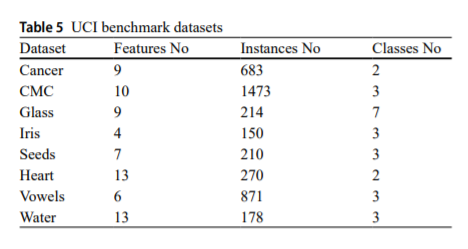Journal of Bionic Engineering (2025) 22:1400–1433https://doi.org/10.1007/s42235-025-00694-9
Improved Geyser-Inspired Optimization Algorithm with Adaptive Turbulence and Dynamic Pressure Equilibrium for Data Clustering
Laith Abualigah1 · Saleh Ali Alomari2 · Mohammad H. Almomani3 · Raed Abu Zitar4 · Hazem Migdady5 · Kashif Saleem6 · Aseel Smerat7,8,9 · Vaclav Snasel10 · Absalom E. Ezugwu11
1 Computer Science Department, Al al-Bayt University, Mafraq 25113, Jordan
2 Faculty of Information Technology, Jadara University, Irbid 21110, Jordan
3 Department of Mathematics, Facility of Science, The Hashemite University, P.O. Box 330127, Zarqa 13133, Jordan
4 Faculty of Engineering and Computing, Liwa College, Abu Dhabi, United Arab Emirates
5 CSMIS Department, Oman College of Management and Technology, 320 Barka, Oman
Abstract
While Metaheuristic optimization techniques are known to work well for clustering and large-scale numerical optimization, algorithms in this category suffer from issues like reinforcement stagnation and poor late-stage refinement. In this paper, we propose the Improved Geyser-Inspired Optimization Algorithm (IGIOA), an enhancement of the GeyserInspired Optimization Algorithm (GIOA), which integrates two primary components: the Adaptive Turbulence Operator (ATO) and the Dynamic Pressure Equilibrium Operator (DPEO). ATO allows IGIOA to periodically disrupt stagnation and explore different regions by using turbulence, while DPEO ensures refinement in later iterations by adaptively modulating convergence pressure. We implemented IGIOA on 23 benchmark functions with both unimodal and multimodal contours, in addition to eight problems pertaining to cluster analysis at the UCI. IGIOA, out of all the tested methods, was able to converge most accurately while also achieving a stable convergence rate. The mitigation of premature convergence and low-level exploitation was made possible by the turbulence and pressure-based refinements. The findings from the tests confirm that the adaptation of baseline strategies by IGIOA helps deal with complex data distributions more effectively. However, additional hyperparameters which add complexity are introduced, along with increased computational cost. These include automatic tuning of parameters, ensemble or parallel variations, and hybridization with dedicated local search strategies to extend the reach of IGIOA for general optimization while also specializing it for clustering focused tasks and applications.
Keywords IGIOA · Metaheuristics · Clustering · Turbulence operator · Pressure equilibrium

Copyright © 2025 International Society of Bionic Engineering All Rights Reserved
吉ICP备11002416号-1









